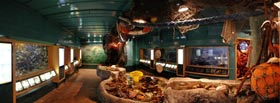University temporarily closes Aquarium to public from today

The University of Otago is closing its Aquarium facility to the public from today (Friday June 1) following a recent assessment showing the 1960s-built structure is earthquake prone.
University Property Services Director Barry MacKay says the two-storey building on the seaward side of the Marine Science complex has been assessed (as part of a University-wide risk assessment programme) to be less than 15 percent of the new building standard for earthquake strength.
The decision to close the building is consistent with the University’s recently announced policy to close any building which is earthquake prone and rates less than 15% of new building standard.
The much larger 1980s-built marine laboratory immediately adjacent, and the newer New Zealand Marine Studies Centre on the landward side of the complex, remain unaffected by the temporary closure. The outdoor fish-holding spaces underneath the 1980s-built structure next door, housing larger fish including sharks, is also unaffected.
Mr MacKay says that equipment and tanks containing fish in the affected aquarium building will remain so that they can be attended by research staff, and it is planned to immediately strengthen these areas with temporary propping and bracing to allow this.
The aquarium is the smallest of the three main buildings within the complex. It has been a 7-day-a-week public operation with some 20,000 visitors a year. The aquarium houses about 100 different types of fish. The affected building also houses a laboratory and teaching space, and a common room, but no staff office space.
Head of Marine Science Professor Gary Wilson says with the main marine laboratory and marine studies centre unaffected, research and schools’ educational programmes will continue without interruption by relocating the activities that would have been undertaken at the aquarium building in to the unaffected buildings.
Temporary tanks and facilities would be set up in the New Zealand Marine Studies Centre for teaching purposes while an assessment is made of how the aquarium facility will be accommodated in the future, he says.
Professor Wilson adds that staff normally employed in public outreach programmes will be redeployed, as required, to assist with development of replacement facilities.
Pro-Vice-Chancellor Division of Sciences Professor Keith Hunter says he understands the public will be inconvenienced by the move. However, while options for upgrading or replacing the aquarium facility “as soon as practicable” are being worked through, the facility will remain closed.
"Safety is of course our most important priority. We also need to work to minimise the immediate impact on our important teaching and research activities that involve marine animals. We are confident the issues can be overcome through careful planning," he says.
